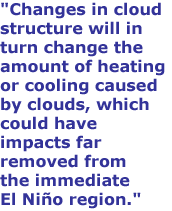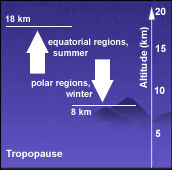

 |
|||
|
In 1998, the strongest El Niño event on record wreaked havoc on global weather. A crippling ice storm inundated the northeastern United States and eastern Canada, bringing down trees and power lines and leaving two million homes without power for more than two weeks. Record-high ocean surface temperatures may have killed as much as 10 percent of the world's coral during the 1997-1998 El Niño winter, a spokesperson for the National Marine Fisheries Service said in a recent Nature Conservancy article.
|
October 11, 2001

 The tropopause, the boundary between the troposhpere and stratosphere, varies from 18 km in equatorial regions in the summer to 8 km in the polar regions in the winter. (Image courtesy of Goddard Space Flight Center) For more information, visit the Langley Atmospheric Sciences Data Center. (A new browser window will open.) |
||
|
Clouds play a fundamental role in maintaining the Earth's energy balance, or "radiation budget," the amount of radiation that enters and leaves the Earth. Through a process known as "shortwave cooling," clouds reflect some of the sun's radiation back into space, which has a net cooling effect on the Earth's surface-atmosphere system. At the same time, clouds help contain the radiation that would otherwise be emitted to space, through "longwave warming," which has a net warming effect on the climate system. Until recently, scientists were uncertain whether clouds had an overall net cooling or heating effect on the Earth's climate. But recent studies show that, in the tropics, a "near cancellation" between shortwave cooling and longwave warming exists, which indicates that the amount of incoming radiant energy is roughly equal to the amount of outgoing radiation. However, small changes in tropical cloudiness can disrupt this precarious balance. "The Pacific warm pool is a region of warm sea surface temperatures stretching from the western waters of the equatorial Pacific to the eastern Indian Ocean," said Robert Cess, professor and researcher at the Marine Sciences Research Center at the State University of New York at Stony Brook. "In normal years, and during most average El Niño events, high-level clouds, ranging from thin cirrus to deep convective clouds, cause the near cancellation between shortwave cooling and longwave warming. "During the strong 1998 El Niño, however, our study shows that, in addition to high-level clouds, middle-level clouds also exerted a strong impact upon the warm pool's radiation budget," Cess said. "But since middle-level clouds produce less longwave warming than do high-level clouds, there is no longer a near cancellation between shortwave cooling and longwave warming, so that the net effect of clouds during this El Niño is that of cooling over the warm pool." Cess and colleagues stumbled on the unexpected finding during a routine comparison of two satellite data sets generated by Clouds and the Earth's Radiant Energy System (CERES) and the Earth Radiation Budget Experiment (ERBE). During the potent 1998 El Niño, the near-cancellation between cloud-induced cooling and heating in the Pacific warm pool tipped towards net cooling, and the physical mechanism appeared to be a change in cloud vertical structure. "We weren't really looking too closely at clouds; we were simply checking clear-sky data to make sure both data sets were measuring the same thing," said Cess. "Once we started playing around with the data, we found that both cloud heights and cloud fractional coverage over the warm pool decreased in 1998." Further data analyses, using five years of ERBE data (1985 to 1989) and 1998 CERES data, revealed that, in 1998, shortwave cooling dominated over longwave warming in the Pacific warm pool, Cess reported in the Journal of Climate, along with team members Minghua Zhang, Pi-Huan Wang, and Bruce Wielicki. The researchers first surmised that their finding might be explained by temperature changes in the tropopause, the boundary between the troposphere and the stratosphere. "A similar, but weaker, anomaly had occurred during the 1987 El Niño and was linked to changes in tropopause temperatures," said Cess. "But then we acquired tropopause temperature data for 1998, and clearly it did not explain the 1998 changes — that's when we discovered the change in cloud vertical structure." According to Cess, the team's findings have powerful implications for global climate change. "Changes in cloud structure will in turn change the amount of heating or cooling caused by clouds, which could have impacts far removed from the immediate El Niño region," he said. The ability to observe and monitor cloud cover from space has revolutionized cloud and climate change studies. Although surface observations provide a useful record of cloud phenomena, scientists require observations taken over large areas to obtain more accurate and comprehensive observations of the Earth's cloud cover.
"If you're making observations at the surface, all you see is what's over your head," said Cess. "Satellite imagery provides us with global coverage and long time-series data. We never would have discovered this change in cloud structure without satellite data." Climate models rely heavily on satellite data, but because clouds change rapidly, their structure is difficult to simulate in computer models. Yet, understanding global climate change depends heavily on the ability to accurately model cloud structure and behavior. "The only vehicles we currently have to predict future climatic change are general circulation models, which run on computers," said Cess. "As far as we know, no model has predicted the change in cloud vertical structure we observed in 1998 — that tells us there's a problem with the models. If we're going to have robust climate models, they must predict what we observe." Cess and colleagues are currently involved in follow-up studies, using cloud profiling data from the Stratospheric Aerosol and Gas Experiment II (SAGE-II) sensor aboard the Earth Radiation Budget Satellite (ERBS), to further demonstrate the changes in cloud structure and to identify large-scale circulation patterns responsible for these changes. "Our study serves as only one test of cloud-climate interactions," said Cess. "We need to devise as many investigations as possible to test climate models." Cess, R.D., M. Zhang, B.A. Wielicki, D.F. Young, X. Zhou, and Y. Nikitenko. 2001. The Influence of the 1998 El Niño upon Cloud-Radiative Forcing over the Pacific Warm Pool. Journal of Climate. 14, pp. 2129-2137. Stolzenburg, W. 2001. Nature Feels the Heat. Nature Conservancy. September/October 2001. Changing Global Cloudiness. NASA Facts. June 1999. FS-1999-06-023-GSFC. |
|||